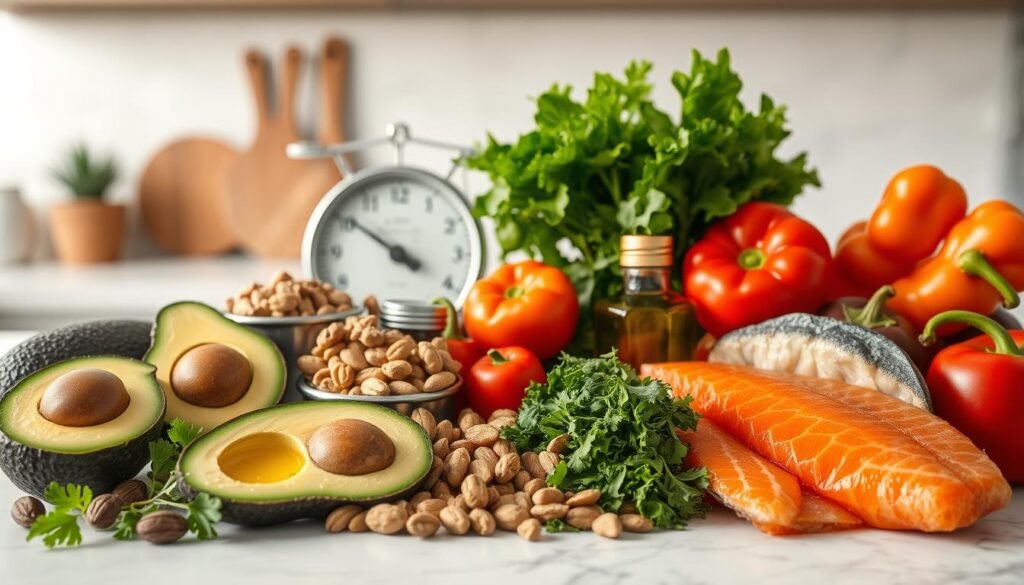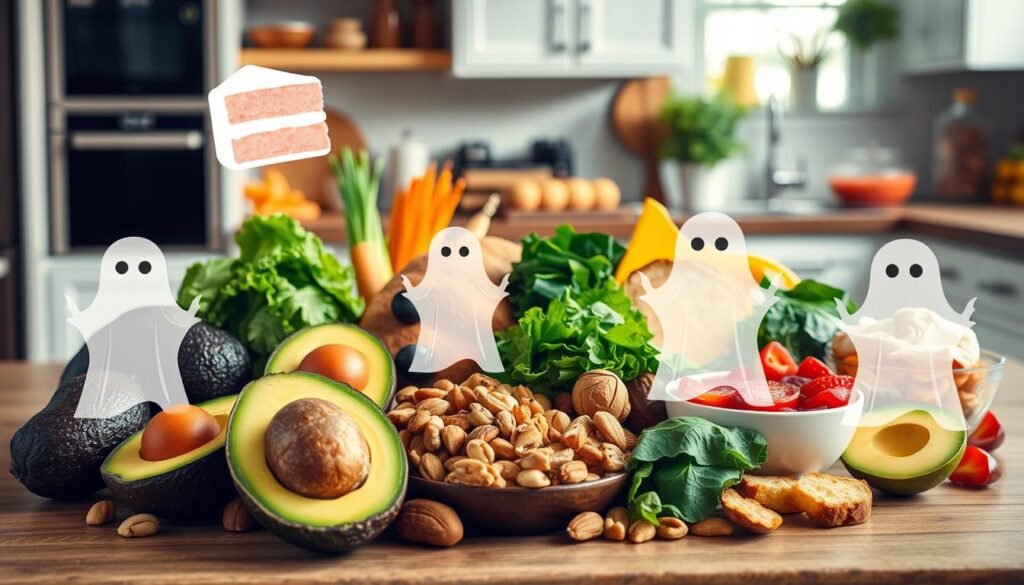Did you know the ketogenic diet is used worldwide for weight loss and managing health issues? It’s a big deal, and it’s time to get the facts straight. Let’s dive into what’s real and what’s not about this popular diet.
In this article, we’ll tackle common myths about the ketogenic diet. We’ll use insights from Maria Emmerich, author of “Keto: The Complete Guide to Success on The Ketogenic Diet”. This will help you understand the keto lifestyle better and make smart choices for your health.
Key Takeaways
- The ketogenic diet is a low-carb, high-fat, and moderate protein plan that induces ketosis, where the body burns fat for fuel instead of carbohydrates.
- Contrary to popular belief, the keto diet does not strictly require 80% of calorie intake to come from fat.
- Keto supplements, such as beta hydroxybutyrate, are not essential for achieving a ketogenic state.
- Urine strips are not the most accurate way to measure ketosis, with blood meters being the recommended method.
- Overconsumption of calories, even on a high-fat diet like keto, can impede weight loss by not utilizing body fat for fuel.
Understanding the Ketogenic Diet Fundamentals
To really get the ketogenic diet, you need to know its basics. The ketogenic diet, or “keto diet,” focuses on a specific mix of nutrients. It has 70-75% fat, 20-25% protein, and just 5-10% carbs. This mix helps the body enter a state called ketosis.
What Defines a True Ketogenic Diet
The standard ketogenic diet (SKD) has 70% fat, 20% protein, and 10% carbs. This mix is what makes it different from other diets like Atkins or Paleo. By cutting carbs so much, the body starts using fat for energy instead of sugar.
The Science Behind Ketosis
Ketosis happens when you eat very few carbs. This makes the body use fat for energy instead of sugar. Research shows the keto diet can improve insulin sensitivity by 75% (25). This shows how ketosis changes the body’s energy use.
Macronutrient Ratios on Keto
Keeping the right balance of nutrients is key for ketosis. People on a keto diet must watch their fat, protein, and carb intake closely. If they don’t, they might not stay in ketosis and miss out on its benefits.
| Macronutrient | Ketogenic Diet Ratio |
|---|---|
| Fat | 70-75% |
| Protein | 20-25% |
| Carbohydrates | 5-10% |
Knowing these basics is key to understanding the ketogenic diet. It helps separate ketogenic diet truths from keto diet realities and keto diet clarifications. With this knowledge, people can decide if the keto diet fits their health goals.
Common Keto Diet Myths and Misconceptions
The keto diet has become very popular, but myths and misconceptions have also grown. It’s important to know the truth about these myths for those thinking about or already on a ketogenic diet.
One big keto myth debunked is that it’s all about protein. Actually, a true keto diet focuses on healthy fats, not too much protein. Too much protein can stop you from getting into ketosis, the diet’s goal.
Another keto diet misconception is that it’s just like any low-carb diet. While they share some traits, keto is unique. It needs strict carb limits to work, unlike other low-carb diets.
- Myth: Keto is the fastest way to lose weight
- Myth: Keto is how humans naturally should eat
- Myth: You can eat unlimited fat on keto
- Myth: You’ll always feel great on the keto diet
These low-carb diet myths can set up wrong expectations and bad use of the keto diet. The truth is, weight loss results differ, and it’s not for everyone long-term. Always talk to a registered dietitian for a safe and effective keto plan.
| Myth | Reality |
|---|---|
| Keto is a high-protein diet | Keto is moderate in protein, with the focus on healthy fats |
| Keto is the same as any low-carb diet | Keto is a distinct approach requiring strict carb restriction to induce ketosis |
| Keto is the fastest way to lose weight | Weight loss results vary, and the diet may not be suitable for everyone long-term |
By clearing up these keto myths, you can start the ketogenic diet with better expectations. You’ll understand how to make it work for your needs.
“The keto diet is not a one-size-fits-all approach, and it’s essential to consult with a professional to ensure it’s the right fit for your health goals and lifestyle.”
The Truth About Protein Consumption on Keto
Many people think the keto diet is all about eating a lot of protein. But, it’s actually about keeping protein intake moderate. This is usually around 20-25% of your daily calories. Too much protein can kick you out of ketosis because your body turns it into glucose.
Optimal Protein Intake Guidelines
The right amount of protein on a keto diet depends on several things. These include how active you are, your body type, and if you’re trying to lose weight. Here’s a basic guide:
- If you’re not very active, aim for 0.6 – 0.8g of protein per pound of lean body mass.
- For those who are more active, go for 0.8 – 1.0g of protein per pound of lean body mass.
- Weightlifters should aim for 1.0 – 1.2g of protein per pound of lean body mass.
Impact of Excess Protein on Ketosis
Protein is important for muscle health and recovery. But eating too much can mess with ketosis. This is because your body can turn protein into glucose. Yet, studies show this doesn’t happen much, even with too much protein.
Best Protein Sources for Keto
For a ketogenic diet, choose high-quality protein sources. These include:
- Meat (like beef, chicken, and pork)
- Fish and seafood
- Eggs
- Dairy products (cheese and heavy cream)
By sticking to these keto-friendly options, you can get enough protein. This helps you stay in ketosis and supports your health and fitness goals.
“Eating adequate protein on the ketogenic diet is beneficial for fat loss, as protein is more satiating than fat, nutrient-dense, and helps prevent overeating.”
Debunking Fat Consumption Myths
There are many myths about high-fat diets like the keto diet. Fat is key in the keto diet, but too much can slow down weight loss.
It’s important to eat healthy fats like those in avocados, nuts, olive oil, and fatty fish. These keto diet facts help keep fat intake balanced. It’s not about eating all the fat you can, but finding the right mix of fats for health.
Controlling portions and being mindful of fat intake is key for the keto diet. Fat has a lot of calories (9 per gram), so eating too much can stop weight loss, even with diet benefits.
- Avoid the myth of unlimited fat consumption on keto
- Focus on incorporating healthy, unsaturated fats into your diet
- Practice portion control to prevent excessive fat intake and weight gain
- Maintain a balance of saturated and unsaturated fats for optimal health
By clearing up these keto diet side effects about fat, you can follow the ketogenic lifestyle better and more effectively.

“A proper low-carb diet should involve 20%-40% protein, emphasize vegetables, and healthy fats for heart health.”
Weight Loss Reality on the Ketogenic Diet
The ketogenic diet’s weight loss reality is often misunderstood. The initial weight loss can be fast, up to 10 pounds in two weeks. But, most of this is water weight, not fat. Ketosis weight loss is slow, and studies show similar results after a year as other diets.
Initial Water Weight vs. Fat Loss
The ketogenic diet makes your body burn fat instead of carbs. This leads to losing water weight as your body releases glycogen and water. But, the actual fat loss might not be as big as the initial weight loss.
Long-term Weight Management
Managing weight long-term on the ketogenic diet needs a long-term plan and lifestyle changes. Keto diet realities show that sticking to the diet, calorie intake, and metabolism play big roles in weight loss success.
Factors Affecting Weight Loss Success
- Adherence to the ketogenic diet
- Overall calorie intake
- Individual metabolic factors
Weight loss on the ketogenic diet is complex. It’s not just about following the diet. Knowing about ketosis weight loss, keto diet facts, and keto diet realities helps set realistic goals. It helps in developing a lasting plan for health and wellness.
The Difference Between Low-Carb and Keto Diets
The terms “low-carb” and “keto” are often mixed up, but they’re not the same. Knowing the main differences between these diets is key to finding the best fit for your health goals.
A low-carb diet lets you eat 50 to 150 grams of carbs daily, which can be very beneficial. On the other hand, a keto diet limits carbs to 20 to 50 grams daily. This strict carb limit forces your body into ketosis, where it burns fat instead of sugar.
Protein intake varies between the two diets. Low-carb diets often have more protein, but keto diets need only moderate amounts to stay in ketosis. Eating too much protein can stop your body from entering ketosis.
| Metric | Low-Carb Diet | Keto Diet |
|---|---|---|
| Carb Intake | 50-150 grams per day | 20-50 grams per day |
| Protein Intake | Higher protein | Moderate protein |
| Fat Intake | Moderate to high | High (70-80% of total calories) |
| Metabolic State | Variable | Ketosis |
The keto diet is a special kind of low-carb diet aimed at keeping you in ketosis. Both diets can be healthy, but the keto diet might be harder to stick to because of its strict rules. For many, a less strict low-carb diet could be easier and more lasting.
Understanding Ketosis and Body Adaptation
The ketogenic diet puts your body into ketosis. This is a natural state where your body uses ketones for energy instead of glucose. This change can bring many benefits but also has its challenges.
Signs of Ketosis
Signs you’re in ketosis include:
- Increased ketone levels in your blood, urine, or breath
- Decreased hunger and cravings
- Improved mental focus and energy
Managing Keto Flu Symptoms
Some people get the “keto flu” when starting. It causes fatigue, nausea, headaches, and more. These symptoms come from losing too much fluid and electrolytes. Drinking enough water and taking supplements can help.
Timeline for Adaptation
Adapting to a keto diet takes about 1-2 weeks. Your body changes a lot, like making more ketones and burning fat better. With patience and the right steps, you can smoothly enter ketosis and enjoy its benefits.
| Timeline for Keto Adaptation | Physiological Changes |
|---|---|
| 1-2 weeks |
|
| 4-12 weeks |
|
Knowing about the keto diet realities and how your body adapts helps. It makes it easier to get past the initial hurdles and succeed on a ketosis diet in the long run.
Common Supplement and Testing Misconceptions
There are many myths about supplements and testing in the ketogenic diet. One myth is that you need keto supplements like beta-hydroxybutyrate (BHB) to get into ketosis. But your body can make BHB naturally if you eat a true ketogenic diet.
Another myth is that urine testing strips are the best way to check ketone levels. While they can show if you’re in ketosis, blood meters are more accurate. It’s also not necessary to chase high ketone numbers, as they don’t always mean more fat burning.
Some people think adding MCT oil to carb-heavy meals can start ketosis. This is not true. MCT oil gives energy but won’t start ketosis if you eat a lot of carbs.
Knowing these myths can help you save money and focus on better ways to succeed on the keto diet. Instead of relying on supplements or testing too much, focus on a well-planned ketogenic diet and watch how your body reacts.
“Keto supplements and testing can be helpful, but they’re not essential for achieving and maintaining ketosis. The real key is sticking to a well-designed keto diet plan.”
Conclusion
The keto diet truth unveiled in this article shows that the ketogenic diet can be effective for weight loss and health issues. It’s important to know the real facts from myths. This way, people can make smart choices about trying a keto diet and the realities uncovered lifestyle.
Starting the keto diet means having realistic goals and eating nutrient-rich foods. It’s also key to know what you need and want. Always talk to a doctor before starting any new diet, even more so if you have health problems.
By understanding the keto diet truth unveiled, you can enjoy its benefits without falling for false information. Begin your path to better health and wellness. Know the ketogenic diet truths and the keto diet realities uncovered well.






Perfect piece of work you have done; this website is really cool with wonderful info.